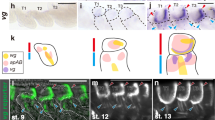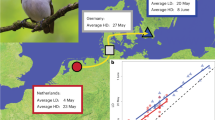Abstract
At 30°C the micropterous females of the sand cricket, Gryllus firmus, begin reproduction at an earlier age after eclosion and have a larger cumulative fecundity than macropterous females. These reproductive costs may offset the advantages of being macropterous and hence capable of migration. The evolutionary significance of this phenotypic trade-off, which is characteristic of wing dimorphic insects in general, is contigent on the traits being genetically correlated. The genetic basis of the phenotypic tradeoff between flight capability and reproduction in the sand cricket, Gryllus firmus, was examined by selecting for increased and decreased incidence of macroptery, and measuring the age schedules of fecundity of macropterous and micropterous females in the selected and control lines. The two traits, wing dimorphism and age schedule of reproduction, are shown to be genetically correlated. Although the mean fecundity within the selected populations changed the fecundities of macropterous and micropterous forms remained constant, suggesting that the age schedule of reproduction may itself be a threshold trait with respect to the continuously varying character controlling the expression of wing form. The relevance of antagonistic pleiotropy to the maintenance of genetic variation for wing form and the age schedule of reproduction is discussed.
Similar content being viewed by others
Article PDF
References
Butler, T. 1987. Population dynamics and dispersal in water-striders: a comparative approach. M.Sc. Thesis, Concordia University, Quebec, Canada.
Denno, R F, Olmstead, K L, and McCloud, E S. 1989. Reproductive cost of flight capability: a comparison of life history traits in wing dimorphic planthoppers. Ecol Ent, 14, 31–44.
Dingle, H. 1985. Migration. In Kerkut, G. A. and Gilbert, L. I. (eds), Comprehensive Insect Physiology, Biochemistry and Pharmacology Vol 9, Behaviour. Pergamon Press, New York.
Dixon, A F G, and Wratten, S D. 1971. Laboratory studies on aggregation, size and fecundity in the black bean aphid, Aphis fabae Scop. Bull ent Res, 61, 97–111.
Fairbairn, D J. 1986. Does alary dimorphism imply dispersal dimorphism in the waterstrider, Gerris remigis? Ecol Ent, 11, 355–368.
Fairbairn, D J. 1988. Adaptive significance ofwing dimorphism in the absence of dispersal: a comparative study of wing morphs in the waterstrider, Gerris remigis. Ecol Ent, 13, 273–281.
Fairbairn, D J, and Desranleau, L. 1987. Flight threshold, wing muscle histolysis, and alary polymorphism: correlated traits for dispersal tendency in the Gerridae. Ecol Ent, 12, 13–24.
Fairbairn, D J, and Roff, D A. 1990. Genetic correlations among traits determining migratory tendency in the sand cricket, Gryllus firmus. Evolution, (In press).
Falconer, D S. 1981. Introduction to Quantiative Genetics. 2nd ed. Longman, London and New York.
Fujisaki, K. 1986. Reproductive properties of the oriental chinch bug, Cavelerius saccharivorus Okajima (Heteroptera: Lygaeidae), in relation to its wing polymorphism. Res Pop Ecol, 28, 43–52.
Harrison, R G. 1980. Dispersal polymorphism in insects. A Rev Ecol Syst, 11, 95–118.
Honěk, A. 1976. Factors influencing the wing polymorphism in Pyrrhocoris apterus (Heteroptera, Pyrrhocoridae). Zool Jb Syst Bd, 103, 1–22.
Inglesfield, C, and Begon, M. 1983. The ontogeny and cost of migration in Drosophila subobscura Collin. Biol J Linn Soc, Lond, 167, 76–96.
Johnson, C G. 1969. Migration and Dispersal of Insects by Flight. Methuen, London.
Maynard Smith, J. 1978. Optimization theory in evolution. A Rev Ecol Syst, 9, 31–56.
Mochida, O. 1973. The characters of the two wing-forms of Javesella pelucida (F.) (Homoptera: Delphacidae) with special reference to reproduction. Trans R ent Soc Lond, 125, 177–225.
Ritchie, M G, Butlin, R K, and Hewitt, G M. 1987. Causation, fitness effects and morphology of macropterims in Chorthippus parallelus (Orthoptera: Acrididae). Ecol Ent, 12, 209–218.
Roff, D A. 1975. Population stability and the evolution of dispersal in a heterogeneous environment. Oecologia, 19, 217–237.
Roff, D A. 1977. Dispersal in dipterans: its costs and consequences. .J Anim Ecol, 46, 443–456.
Roff, D A. 1984. The cost of being able to fly: a study of wing polymorphism in two species of crickets. Oecologia, 63, 30–37.
Roff, D A. 1986a. The evolution of wing dimorphism in insects. Evolution, 40, 1009–1020.
Roff, D A. 1986b. The genetic basis of wing dimorphism in the sand cricket, Gryllus firmus and its relevance to the evolution of wing dimorphisms in insects. Heredity, 57, 221–231.
Roff, D A. 1989. Exaptation and the evolution of dealation in insects .J evol Biol, 2, 109–123.
Roff, D A. 1990a. Understanding the evolution of insect life cycles: the role of genetical analysis. In, Gilbert, F. (ed.), Genetics, Evolution and Coordination of Insect Life Cycles. Springer-Verlag, Berlin (In press).
Roff, D A. 1990b. Selection for changes in the incidence of wing dimorphism in Gryllus firmus. Heredity, 65, 163–168.
Roff, D A. 1990c. The evolution of flightlessness in insects. Ecol Monogr, (In press).
Roff, D A, and Fairbairn, D J. 1990. Wing dimorphisms and the evolution of migratory polymorphisms among the Insecta. Am Zool, (In press).
Rose, M R. 1982. Antagonistic pleiotropy, dominance and genetic variation. Heredity, 48, 63–78.
Rose, M R. 1983. Theories of life-hostory evolution. Am Zool, 23, 15–23.
Rose, M R. 1985. Life history evolution with antagonistic pleiotropy and overlapping generations. Theor Pop Biol, 28, 342–358.
Solbreck, C. 1986. Wing and flight muscle polymorphism in a lygaeid bug, Horvathiolus gibbicollis: determinants and life history consequences. Ecol Ent, 11, 435–444.
Southwood, T R E. 1962. Migration ofterrestrial arthropods in relation to habitat. Biol Rev, 37, 171–214.
Stearns, S C. 1976. Life-history tactics: a review of the ideas. Q Rev Biol, 51, 3–47.
Stearns, S C. 1977. The evolution of life-history traits: a critique of the theory and a review of the data. Ann Rev Ecol Syst, 8, 145–171.
Veazey, J N, Kay, C A R, Walker, T J, and Whitcomb, W H. 1976. Seasonal abundance, sex ratio, and macroptery of field crickets in Northern Florida. Ann ent Soc Amer, 69, 374–380.
Walker, T, and Sivinski, J M. 1986. Wing dimorphism in field crickets (Orthopera: Gryllidae: Gryllus). Ann ent Soc Amer, 79, 84–90.
Wratten, S D. 1977. Reproductive strategy of winged and wingless morphs of the aphids Setobion avenae and Metopolophium dirhodum. Ann appl Biol, 85, 319–331.
Zera, A J. 1984. Differences in survivorship, development rate and fertility between the long-winged and wingless morphs of the waterstrider, Limnoporus canaliculatus. Evolution, 38, 1023–1032.
Author information
Authors and Affiliations
Rights and permissions
About this article
Cite this article
Roff, D. Antagonistic pleiotropy and the evolution of wing dimorphism in the sand cricket, Gryllus firmus. Heredity 65, 169–177 (1990). https://doi.org/10.1038/hdy.1990.85
Received:
Issue date:
DOI: https://doi.org/10.1038/hdy.1990.85
This article is cited by
-
Continuous variation in hind wing length of Galerucella grisescens (Coleoptera, Chrysomelidae, Galerucinae) and genetic basis of wing length determination
Applied Entomology and Zoology (2019)
-
Genetic basis and fitness consequences of winglessness in the two-spot ladybird beetle, Adalia bipunctata
Heredity (2004)
-
Quantitative genetics of the trade-off between fecundity and wing dimorphism in the cricket Allonemobius socius
Heredity (1996)
-
Wing dimorphism and the migratory syndrome: Correlated traits for migratory tendency in wing dimorphic insects
Population Ecology (1994)
-
Genetic and ontogenetic variation in behaviour: its possible role in the maintenance of genetic variation in the wing dimorphism of Gryllus firmus
Heredity (1993)



